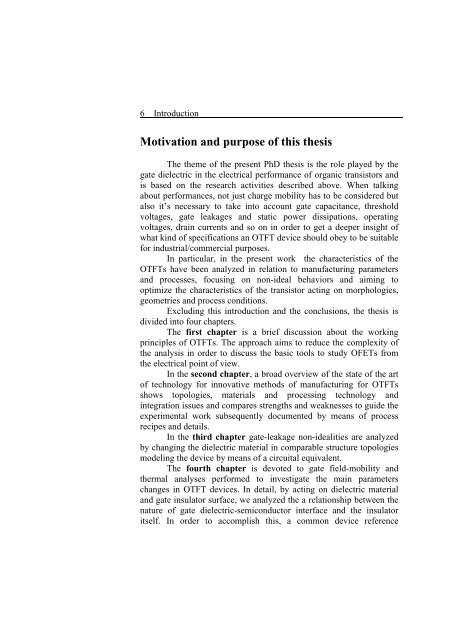tesi R. Miscioscia.pdf - EleA@UniSA
tesi R. Miscioscia.pdf - EleA@UniSA
tesi R. Miscioscia.pdf - EleA@UniSA
Create successful ePaper yourself
Turn your PDF publications into a flip-book with our unique Google optimized e-Paper software.
6 Introduction<br />
Motivation and purpose of this thesis<br />
The theme of the present PhD thesis is the role played by the<br />
gate dielectric in the electrical performance of organic transistors and<br />
is based on the research activities described above. When talking<br />
about performances, not just charge mobility has to be considered but<br />
also it’s necessary to take into account gate capacitance, threshold<br />
voltages, gate leakages and static power dissipations, operating<br />
voltages, drain currents and so on in order to get a deeper insight of<br />
what kind of specifications an OTFT device should obey to be suitable<br />
for industrial/commercial purposes.<br />
In particular, in the present work the characteristics of the<br />
OTFTs have been analyzed in relation to manufacturing parameters<br />
and processes, focusing on non-ideal behaviors and aiming to<br />
optimize the characteristics of the transistor acting on morphologies,<br />
geometries and process conditions.<br />
Excluding this introduction and the conclusions, the thesis is<br />
divided into four chapters.<br />
The first chapter is a brief discussion about the working<br />
principles of OTFTs. The approach aims to reduce the complexity of<br />
the analysis in order to discuss the basic tools to study OFETs from<br />
the electrical point of view.<br />
In the second chapter, a broad overview of the state of the art<br />
of technology for innovative methods of manufacturing for OTFTs<br />
shows topologies, materials and processing technology and<br />
integration issues and compares strengths and weaknesses to guide the<br />
experimental work subsequently documented by means of process<br />
recipes and details.<br />
In the third chapter gate-leakage non-idealities are analyzed<br />
by changing the dielectric material in comparable structure topologies<br />
modeling the device by means of a circuital equivalent.<br />
The fourth chapter is devoted to gate field-mobility and<br />
thermal analyses performed to investigate the main parameters<br />
changes in OTFT devices. In detail, by acting on dielectric material<br />
and gate insulator surface, we analyzed the a relationship between the<br />
nature of gate dielectric-semiconductor interface and the insulator<br />
itself. In order to accomplish this, a common device reference
















